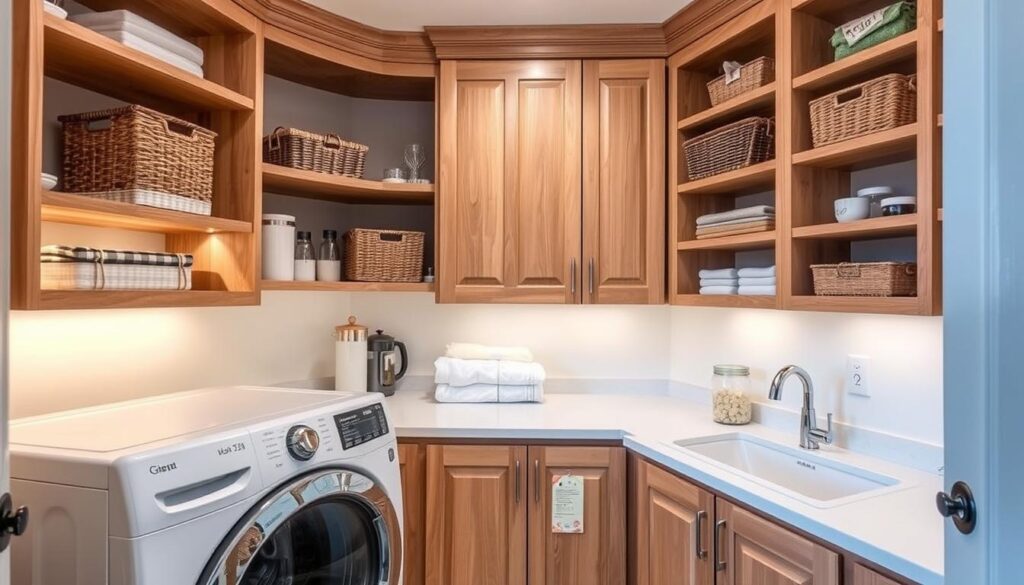Does your laundry area feel more like a chaotic catch-all than a functional space? You’re not alone. Many households struggle with cluttered corners and overflowing supplies. But with a few smart tweaks, you can turn this high-traffic zone into a streamlined hub that simplifies chores and reduces stress.
Whether you have a dedicated room or a compact nook, maximizing vertical space is key. Floating shelves, wall-mounted racks, and stackable bins keep essentials within reach without eating up floor space. Even narrow walls can house foldable drying racks or ironing boards to boost efficiency.
Affordable upgrades make a big difference. Open shelving paired with labeled containers creates order, while slide-out drawers under counters hide bulkier items. For smaller setups, over-the-door organizers or rolling carts add flexibility. The goal? A system that works for your routine—not against it.
Key Takeaways
- Vertical storage maximizes space in tight areas
- Mix open and closed storage to balance accessibility with clutter control
- Multi-functional furniture adapts to different room sizes
- Labels and zones keep supplies organized long-term
- Budget-friendly updates deliver immediate improvements
Creative Layout Ideas for an Efficient Laundry Room
Smart appliance placement can make daily chores quicker and more enjoyable. Start by assessing your washer dryer positioning—door swings should open freely without blocking walkways. Leave at least 42 inches of floor space in front for comfortable loading.
Strategic Appliance Configuration
Side-by-side setups work best in wider areas, while stacked units save floor space in narrow spots. Consider pedestals with built-in drawers to store detergent pods or dryer sheets. Always measure your machines before finalizing the layout.
Smart Space Utilization Techniques
Transform the opposite wall into a functional zone with:
- Floating shelves for stain treatments
- Pegboards for ironing accessories
- Wall-mounted drying racks
This table helps choose the right configuration:
| Layout Type | Width Needed | Ideal For |
|---|---|---|
| Side-by-Side | 60-66″ | Spacious areas |
| Stacked | 30-33″ | Compact spaces |
| L-Shaped | Corner space | Multi-task zones |
Use a floor planner tool to visualize traffic flow. Keep folding stations near dryers, and sorting baskets accessible but out of main pathways. Vertical storage on blank wall surfaces keeps essentials handy without crowding counters.
Essential Laundry Room Storage Solutions for Every Home
Transform your utility zone into a well-oiled machine with clever organizational upgrades. Thoughtful cabinet and shelving choices turn cramped areas into productivity powerhouses that simplify daily tasks.

Incorporating Cabinets, Vanities, and Shelving
Floor-to-ceiling uppers make use of often-wasted vertical real estate. Store cleaning chemicals and seasonal items safely above eye level while keeping daily essentials within reach. Pro tip: Install LED strip lighting under cabinets for better visibility.
A multi-tasking vanity with a built-in sink serves dual purposes:
- Handwash delicates without trekking to bathrooms
- Pre-treat stains right where they happen
The drawers below become prime real estate for stain sticks and mesh bags.
Open shelves keep frequently used supplies visible. Use them for:
- Fabric softener refills
- Stain removal sprays
- Baskets for sock sorting
Choose moisture-resistant materials that complement your home’s aesthetic. Shaker-style fronts offer timeless appeal, while high-gloss finishes reflect light in windowless spaces.
Deep base units become more functional with full-extension drawers and rotating organizers. No more digging through forgotten corners! Check for cabinet sales at local retailers to score quality pieces without overspending.
“Good design lets spaces grow with your needs—today’s detergent shelf becomes tomorrow’s craft supply center.”
Modular shelving systems adapt as needs evolve. Adjust upper shelves for seasonal storage and lower sections for folded towels. Balance closed and open configurations to maintain visual interest while hiding clutter.
Practical Tips for Accessorizing Your Laundry Space
Give your utility area personality while boosting functionality. Smart accessories transform basic setups into tailored systems that work smarter, not harder. Start by mapping your vision with digital tools before committing to physical changes.

Integrating Floor Planner Reviews for Customization
Top-rated apps like RoomSketcher and Planner 5D help test layouts virtually. Check floor planner reviews to compare measurement accuracy and 3D rendering quality. Many tools offer 4th preview angles—critical for spotting blind spots behind appliances.
| Planner | Best Feature | Mobile-Friendly | Free Trial |
|---|---|---|---|
| RoomStyler | Real-time item scaling | Yes | 7 days |
| HomeByMe | Brand catalog integration | iOS only | 14 days |
| Planner 5D | Augmented reality mode | Yes | Limited features |
Seasoned DIYers in planner reviews often mention measuring twice before finalizing cabinet depths. Save your favorite configurations to reference during sales events.
Enhancing Lighting and Decorative Storage Options
Layer three light types for optimal visibility:
- Overhead ceiling fixtures
- Task lighting above sorting stations
- Motion-activated under-cabinet strips
Woven lidded baskets hide cleaning supplies while adding texture. Coordinate colors with nearby dining areas for seamless transitions. Hunt offjuly 4th promotions for premium organizers at big-box retailers.
“Good lighting cuts folding time in half—you’ll spot mismatched socks instantly.”
Label makers and supportcontactsign boards keep households synchronized. Browse discussionsfeatured products on home forums to discover community-approved solutions.
Conclusion
Upgrading your utility area doesn’t require a major overhaul—just clever planning. By implementing the right organizational systems, you’ll transform tedious tasks into streamlined routines. Start with a single improvement, like adding wall hooks or sorting bins, then expand as you see results.
Effective organization pays dividends daily. You’ll spend less time hunting for supplies and more moments enjoying checked-off to-dos. Even modest changes—a labeled jar for loose buttons or sliding drawers under counters—create noticeable efficiency gains.
Every home deserves systems that work seamlessly, regardless of square footage or budget. Whether you’re maximizing vertical real estate or testing layouts digitally, progress happens one step at a time. Let today be the day you reimagine this essential space—your future self will thank you with every load.

